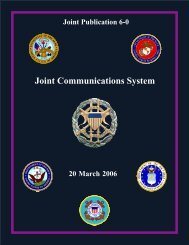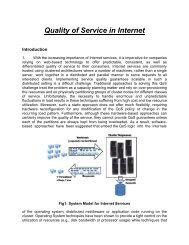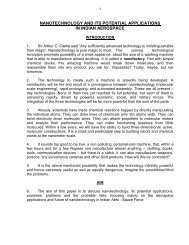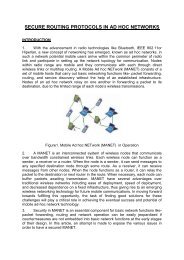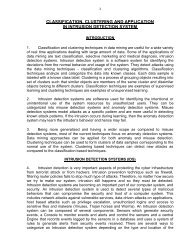Intrusion Detection Systems - Integrated Defence Staff
Intrusion Detection Systems - Integrated Defence Staff
Intrusion Detection Systems - Integrated Defence Staff
Create successful ePaper yourself
Turn your PDF publications into a flip-book with our unique Google optimized e-Paper software.
4abstract attack representation. If an appropriate abstraction can be found, signaturebasedsystems can identify previously unseen attacks that are abstractly equivalent toknown patterns. They are inherently unable to detect truly novel attacks and suffer fromfalse alarms when signatures match both intrusive and nonintrusive sensor outputs.Signatures can be developed in a variety of ways, from hand translation of attackmanifestations to automatic training or learning using labeled sensor data. Because agiven signature is associated with a known attack abstraction, it is relatively easy for asignature-based detector to assign names (such as Smurf or Ping-of-Death) to attacks.Anomaly-based detectors equate “unusual” or “abnormal” with intrusions. Given acomplete characterization of the noise distribution, an anomaly-based detectorrecognizes as an intrusion any observation that does not appear to be noise alone. Theprimary strength of anomaly detection is its ability to recognize novel attacks. Itsdrawbacks include the necessity of training the system on noise with the attendantdifficulties of tracking natural changes in the noise distribution.5. Changes can cause false alarms, while intrusive activities that appear to benormal can cause missed detections. Anomaly- based systems have difficultyclassifying or naming attacks. We can also classify IDSs based on the phenomenologythat they sense. Network-based systems look at packets on a network segment,typically one serving an enterprise or a major portion of one. While network-basedsystems can simultaneously monitor numerous hosts, they can suffer from performanceproblems, especially with increasing network speeds. Many network-based systemsmake simplifying assumptions about such network pathologies as packet fragmentationand can suffer from resource exhaustion problems when they must maintain attackstateinformation for many attacked hosts over a long period of time.6. In spite of these deficiencies, they are popular because they are easy to deployand manage as standalone components and they have little or no impact on theprotected system’s performance. Host-based systems operate on the protected host,inspecting audit or log data to detect intrusive activity. A variety of log and auditfunctions can serve to drive ID algorithms; these can be supplemented by sensors thatmonitor the interaction of applications with the host operating system. Host-basedsystems can monitor specific applications in ways that would be difficult or impossible ina network-based system. They can also detect intrusive activities that do not createexternally observable behavior. Because they consume resources on the protectedhost, they can affect performance substantially. Successful intrusions that gain highlevels of privilege might be able to disable host-based IDSs and remove traces of theiroperation. Installing and effectively using IDSs on networks and hosts requires a broadunderstanding of computer security.Preparation




